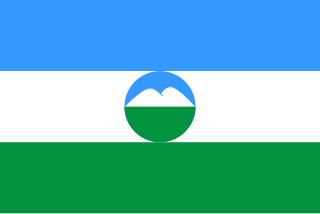| ||
 Gubernatorial Gubernatorial of another subject Legislative Gubernatorial and legislative | ||
Election Day in Russia was held on September 14, 2014.
| ||
 Gubernatorial Gubernatorial of another subject Legislative Gubernatorial and legislative | ||
Election Day in Russia was held on September 14, 2014.
1 Internationally recognised as part of Ukraine, see political status of Crimea and annexation of Crimea by the Russian Federation for details
| | This section needs expansion. You can help by adding to it. (January 2014) |
| | This section needs expansion. You can help by adding to it. (January 2014) |

Karachay-Cherkessia, officially the Karachay-Cherkess Republic, is a republic of Russia located in the North Caucasus. It is administratively part of the North Caucasian Federal District. As of the 2021 census, Karachay-Cherkessia has a population of 469,865. Cherkessk is the largest city and the capital of the republic.

An Autonomous Soviet Socialist Republic was a type of administrative unit in the Soviet Union (USSR), created for certain ethnic groups to be the titular nations of. The ASSRs had a status lower than the constituent union republics of the USSR, but higher than the autonomous oblasts and the autonomous okrugs.

A krai is a type of federal subject of the Russian Federation. The country is divided into 85 federal subjects, of which nine are krais. Oblasts, another type of federal subject, are legally identical to krais and the difference between a political entity with the name "krai" or "oblast" is purely traditional; both are constituent entities equivalent in legal status in Russia with representation in the Federation Council. During the Soviet era, the autonomous oblasts could be subordinated to republics or krais, but not to oblasts. Outside of political terminology, both words have a very similar general meaning and can often be used interchangeably. When a distinction is desirable, "krai" is sometimes translated into English as "territory", while "oblast" can variously be translated to "province" or "region", but both of these translations are also reasonable interpretations of "krai".

Autonomous okrugs are a type of federal subject of the Russian Federation and simultaneously an administrative division type of some federal subjects. As of 2024, Russia has four autonomous okrugs of its 83 federal subjects. The Chukotka Autonomous Okrug is the only okrug which is not subordinate to an oblast. The Nenets Autonomous Okrug is a part of Arkhangelsk Oblast, the Khanty-Mansi Autonomous Okrug and the Yamalo-Nenets Autonomous Okrug are parts of Tyumen Oblast.

Russia is divided into twelve economic regions — groups of federal subjects sharing the following characteristics:

The federal subjects of Russia, also referred to as the subjects of the Russian Federation or simply as the subjects of the federation, are the constituent entities of Russia, its top-level political divisions. According to the Constitution of Russia, the federation consists of republics, krais, oblasts, cities of federal importance, an autonomous oblast, and autonomous okrugs, all of which are equal subjects of the federation.

Kabardino-Balkaria or Kab-Balk, but officially the Kabardino-Balkarian Republic, is a republic of Russia located in the North Caucasus. As of the 2021 Census, its population was 904,200. Its capital is Nalchik. The area contains the highest mountain in Europe, Mount Elbrus, at 5,642 m (18,510 ft). Mount Elbrus has 22 glaciers that feed three rivers — Baksan, Malka and Kuban. The mountain is covered with snow year-round.

.ru is the Latin alphabet Internet country code top-level domain (ccTLD) for Russia introduced on 7 April 1994. The Russian alphabet internationalized country code is .рф.
A selsoviet is the shortened name for a rural council and for the area governed by such a council (soviet).

This gallery of flags of federal subjects of Russia shows the flags of the 89 federal subjects of Russia including two regions that, while being de facto under complete Russian control, are not internationally recognized as part of Russia, and four regions that, while not being fully controlled by Russia or recognised internationally, are claimed by it as its federal subjects.
Autonomous oblasts of the Union of Soviet Socialist Republics were administrative units created for a number of smaller nations, which were given autonomy within the fifteen republics of the USSR.
The Kabardino-Balkarian Autonomous Oblast was an autonomous oblast within the Kabardino-Balkaria region of the Soviet Union. The Oblast was formed in 1921 as the Kabardin Autonomous Oblast before becoming the Kabardino-Balkarian Autonomous Oblast on 16 January 1922. On 16 October 1924 it became part of the North Caucasus Krai, but was separated from it on 5 December 1936, elevated in status and renamed the Kabardino-Balkarian Autonomous Soviet Socialist Republic.
The following lists events that happened during 1951 in the Union of Soviet Socialist Republics.

The 2019 Russian regional elections took place on 8 September 2019 for the election of governors in 19 subjects, among which 16 by direct votes and 3 by indirect votes, and of legislatives bodies in 13 subjects.

Legislative constituencies are used in Russia to elect half of the seats (225) in the State Duma. Each Federal Subject gets a certain amount of constituencies, proportional to their population, with every Federal Subject getting at least one. Every constituency is a single-mandate one, meaning each constituency sends one representative to the State Duma.

The 2021 Russian regional elections took place in Russia on Sunday, 19 September 2021 with possibility of voting on 17 and 18 September provided by the electoral authorities. There will be the legislative election for the 8th State Duma, ten gubernatorial elections, 39 regional parliamentary elections, and many elections on the municipal and local level.

Numerous proposed federal subjects have been put forward since the dissolution of the Soviet Union that would partition existing federal subjects of the Russian Federation. Many new federal subjects were declared in the 1990s, most of them were not recognized, while others, like Adygea and Altai Republics, which were previously autonomous oblasts, were recognized.